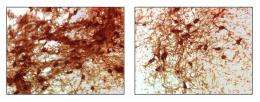Sensitive nerve cells

In Germany alone, more than 300,000 people are afflicted by Parkinson's disease and the number is growing steadily. However, despite comprehensive research, scientists are still somewhat in the dark as to the molecular changes that trigger this illness. Scientists at the Max Planck Institute of Neurobiology in Martinsried, Germany, together with colleagues from Munich and Hamburg, have demonstrated using a new animal model that nerve cells do not begin to die to the extent found in "Parkinson's" in mice until three conditions come together. These findings, which are published next week in the online, open access journal PLoS Biology, are an important step forward in understanding this illness.
In the last ten years, various genes that play a role in the outbreak of the hereditary form of Parkinson's disease have been identified. In addition, nerve cell growth factors, such as GDNF, have been found to reduce the rate at which nerve cells are destroyed in the brain areas afflicted in Parkinson's disease, most notably the substantia nigra of the midbrain. However, the treatment with GDNF and other similar growth factors have not yet left the clinical trial phase. As the brain cells dying in Parkinson's disease are embedded in sensitive brain tissue, their detailed investigation is impossible in humans. The development of animal models in which defined genetic and/or pharmacological manipulations can be made is therefore essential for a good understanding of the molecular and cellular causes of the disease. However, a major drawback of Parkinson's research is that so far most animal models fail to display the accelerated loss of nerve cells typical of the human illness, thus preventing a thorough analysis of Parkinson's disease mechanisms. As the world's population ages, there is an upward trend of the number of people afflicted and the need for effective forms of treatment becomes more urgent. Current treatments aim to ameliorate symptoms, since the underlying disease mechanisms remain unknown.
Rüdiger Klein and colleagues have now been able to show that a significant cell death in the substantia nigra occurs only when three conditions join forces. In a mouse model, three prerequisites had to be fulfilled: a defective disease gene (in this case the DJ-1 gene); a deficiency in responding to a growth factor; and the aging of the animal. In other words, nerve cells which lack the DJ-1 gene and which, in addition, cannot react to the pro-survival signals initiated by the growth factor are particularly prone to die as the mouse ages. "Although we had an inkling that this might be the case, we had no actual proof up to now," Liviu Aron, the first author of this study, explains.
"The discovered connection between the response to a growth factor and the DJ-1 gene is extremely interesting," adds Klein. "Environmental factors influence the supply of growth factors and their interactions with genetic factors may help us to better understand Parkinson's disease." The detailed analysis of the complex mechanisms that set in during the process of aging is likely to keep scientists busy for some time.
Complementary genetic investigations in the fruit fly Drosophila also revealed a connection between growth factor responses and the DJ-1 gene. The researchers thus assume that this interaction arose early in evolutionary history and has since then been preserved. This newly discovered connection may open up a new form of therapy for patients with certain genetic defects that give them a higher predisposition for the disease: for example, a specific medication with GDNF might be more effective in curbing the development of the illness in these than in other patients.
More information: Aron L, Klein P, Pham T-T, Kramer ER, Wurst W, et al. (2010) Pro-Survival Role for Parkinson's Associated Gene DJ-1 Revealed in Trophically Impaired Dopaminergic Neurons. PLoS Biol 8(4): e1000349. doi:10.1371/journal.pbio.1000349

















